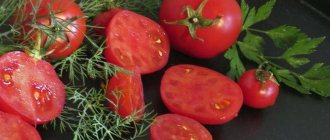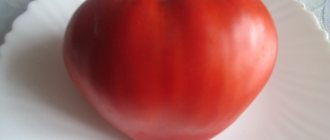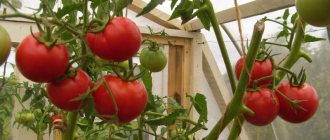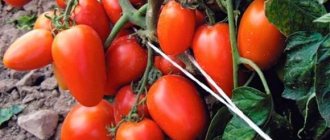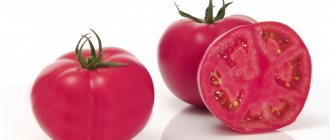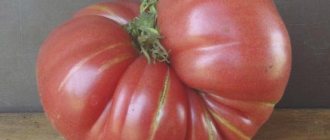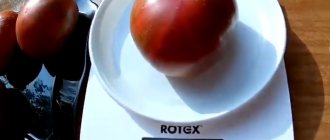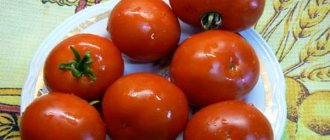Barnaul cannery is a godsend for lovers of low tomato bushes. The variety is distinguished by its productivity and early ripening of tasty tomatoes.
| Height | Landing location | Ripening time | Fruit color | Fruit size | Origin | Fruit shape |
| short | Greenhouse, Open ground | Early ripening | Reds | Small | Variety | Plum-shaped or oval |
Characteristics and description
Determinate plant. Early ripening, the period from its planting to the start of harvesting is from 90 to 100 days. The stems of the “Barnaul tomato” grow up to 50 cm. The leaves are small with a noticeable cross-section. Above the 5th leaf you can observe the formation of the first inflorescence, the next ones are formed through the leaf. From one bush you can collect up to 10 smooth, small fruits, which will look good in a jar, since they will not crack under the influence of high temperatures during preservation. The weight of one ripe tomato does not exceed 50 - 65 g. The fruits are red in color with an orange tint and have a classic sphere shape. They have 2 chambers inside. The taste is sweet with a recognizable tomato sourness.
The most productive varieties of Siberian selection
If we talk about tomatoes of Siberian selection, very productive ones are rare - after all, the growing conditions make themselves felt. But it is quite possible to select a sufficiently productive variety. But “Siberians” are distinguished by strong roots, and they are also cold-resistant. Below is a description of the most popular varieties.
short
Low-growing tomatoes for Siberia are suitable for open ground.
Determinate tomatoes
- Heavyweight of Siberia. Despite the plant’s short growth (about 50 cm), the fruits reach impressive sizes. The stem is not very strong, so the Heavy needs a garter. It is advisable to support the heaviest hands. The variety tolerates low temperatures well, but heat is destructive for it. Therefore, it is not grown in warm regions.
- Sanka. Early ripening variety. The ripening period is only 80-85 days. It is characterized by high productivity; from 1 m² you can harvest 15 kg of tomatoes. Fruits until the first frost.
- Demidov. Compact, non-branching plants that do not need to be pinched. Sweet dark pink fruits weigh no more than 120 g.
- Petrusha is a gardener. The fruits are cylindrical in shape with a pointed crown and resemble the cap of a fairy-tale hero. The variety is resistant to late blight and rot.
- Nobleman. The plants have a strong stem and need staking only during the period of mass ripening of tomatoes. The fruits are very large (up to 1.5 kg), heart-shaped.
- Alsou. The most popular tomato variety for Siberia. From 1 m² you can harvest up to 9 kg of large, fleshy tomatoes.
Tall
Indeterminate varieties:
- Sugar Bison. High-yielding greenhouse variety for the northern regions of Western Siberia. The fruits are raspberry-pink, average weight - 250-300 grams. Used for fresh consumption, making juices or sauces.
- Grandma's secret. Plant height is 1.5-1.7 m. A garter and removal of stepsons is necessary. The fruits are large (up to 1 kg), fleshy.
- Andrew's surprise. Late-ripening self-pollinating variety. The seedlings tolerate a lack of light well. Fruit weight - 200-500 g. Productivity - up to 5 kg per bush.
- Eagle beak. Mid-season salad variety. The fruits are large (about 600 g), dense, and tolerate transportation well. Productivity - up to 15 kg/m².
Well-known agricultural companies
The production of tomato varieties and hybrids is carried out by the agro company Seeds of Altai. Companies annually update the catalog of tomato seeds of Siberian selection.
The Siberian malachite variety can surprise you with its colors
| Agrofirm | Name | Main characteristics |
| Siberian Garden | Siberian apple | Indeterminate hybrid. The ripening period is 100-115 days. The average yield is 9 kg/m². The fruits are round, juicy, and have a thick skin. |
| Siberian malachite | Indeterminate variety. It is desirable to form 2-3 stems. Productivity - 10 kg/m². The fruits are green-yellow in color and resistant to cracking. | |
| Novosibirsk hit | Medium-sized hybrid. Tolerates sudden cold spells. The ripening period is 100-110 days. Productivity - 7 kg per bush. Requires regular feeding and garter. | |
| Altai seeds | King of Siberia | Indeterminate variety. Tomatoes are orange in color and are suitable for people who are allergic to red fruits. Average weight - 500 g. Productivity - 4.5 kg per bush. |
| Bulls-eye | Tall early variety. Ripening period is 90-95 days. The fruits are round and glossy. Average weight - 20-30 g. Productivity - 2.5 kg per plant. | |
| Rugby | Low-growing, early-ripening hybrid. The ripening period is 90-95 days. The fruits are bright red, elongated-cylindrical. Average weight - 90-110 g. Average yield - 17 kg/m². |
Advantages of the variety
Many years of experience in growing the “Barnaul tomato” have made it possible to highlight some of the advantages why summer residents choose it.
- Early ripeness;
- Dense structure with juicy pulp;
- Excellent for preservation;
- Harmonious ripening of fruits of equal size;
- Does not require a garter;
- Resistant to pests and diseases;
- Transportable;
- Tolerates a decrease in temperature to + 12 – 13 degrees, which for ordinary varieties threatens to stop development.
Advantages of varieties of Siberian selection
Every year, Siberian vegetable varieties are becoming increasingly popular among gardeners. Specially bred varieties for Siberia are distinguished by disease resistance, high yield and rapid ripening in conditions of short summers, sudden temperature changes, and little sunlight. Despite the fact that the tomato is a heat-loving crop, in the conditions of a sharply continental climate, gardeners in Siberia receive a decent harvest of tasty, aromatic fruits. Tomatoes of Siberian selection are suitable for the Urals and central Russia, for areas of risky farming, where summer also does not indulge in an abundance of heat and sun.
The future harvest depends entirely on correctly selected seeds. Decide what requirements you will make for the future plant:
- Ripening time;
- Growing method;
- Taste qualities;
- Shape and height of the bush;
- Productivity.
So, you have selected future tomatoes according to your criteria and selected the most productive tomato seeds of Siberian selection. Tomatoes from Siberian breeders are suitable for cultivation both in open and protected ground. Growing without protection is risky farming; the harvest depends too much on the whims of Mother Nature. In a greenhouse, you are guaranteed to get a harvest that is much more abundant than in open ground and faster by almost 3 weeks. And tomatoes at technical ripeness can be picked directly from the bush. It is unlikely that you will see ripe tomatoes standing in open ground. But it is at the beginning of summer that the body wants more vitamins.
Caring for the future harvest begins in the spring, even in winter, when the time comes to plant seeds for seedlings. Before planting, harden the seeds. Place the barely hatched seeds in the refrigerator for 12 hours, then remove and leave for a day at room temperature. So, repeat 2-3 times. Experienced gardeners claim that productivity increases by 30-40 percent. Tomato seedlings respond very positively to good lighting and warmth. Don't forget to turn the plants, so they won't stretch out and will be strong. How to care for tomato seedlings, watch the video:
In April - May, carry out the hardening process of young plants. Open the window and take the boxes with seedlings out onto the balcony during the day. When the plants reach a height of approximately 30 cm, they are ready to be transplanted into the greenhouse soil. Plant tall varieties and hybrids in a row or in a checkerboard pattern at a distance of 40–60 cm. Prepare the soil mixture in the greenhouse in advance. Tomatoes love sandy loam or light loamy soil.
Attention! The composition of the soil is improved by adding humus, rotted manure, and peat. Before planting, fill the holes with a solution of potassium permanganate, slightly pink in color.
Before planting, spill the holes with a slightly pink solution of potassium permanganate.
Further care consists of regular watering and removal of shoots. Don't overdo it with watering. Otherwise, you will end up with watery tomatoes that won't taste good and will crack. Water once every 5 days. Removing stepchildren is the most important process for gardeners. It is best to remove side shoots that have not outgrown the size of 5 cm. Tie up the seedlings after 14 days.
Growing and care
It is permissible to grow both by sowing directly into the ground, under a film covering in the open ground, and in greenhouse conditions by seedlings with or without the use of growth stimulants.
On a note! When planting, seedlings must be at least 55–60 days old.
+ 25 degrees is a suitable temperature for the development of seedlings.
As soon as the seedlings reach a height of more than 8 cm, it is recommended to harden them. It is enough to put it in a cool place for 15 – 20 minutes a couple of times a day. There is enough ventilation in the greenhouse.
The Barnaul canned tomato grows well in those places where they previously grew: greens, cabbage, carrots. Plants do not require complex care, just basic rules are enough: timely watering, regular loosening, fertilizing and do not forget about pinching, leaving no more than 3 trunks. When planting, the most suitable scheme is for 1 square. m plant no more than 7 - 8 bushes with a calculation of 50x40.
Description of the Siberian early ripening tomato variety: characteristics and growing regions
The Siberian early ripening tomato variety was included in the State Register of the Russian Federation back in 1959. The list of areas where its cultivation is officially recommended is impressive: these are the Northern, Northwestern, Central, Volga-Vyatka, Middle Volga, West Siberian, Ural, West Siberian, East Siberian and Far Eastern regions. As we can see, only warm edges and areas are missing from the list, which may seem strange: after all, tomatoes love warmth. But Siberian early ripening is a tomato created specifically for cool climates, and in conditions of excessive heat it feels uncomfortable.
Its purpose is universal - the variety can be cultivated both in unprotected soil and using film shelters. In both options, the yield of the variety is approximately the same, so the choice of growing conditions is determined by the climate of the region, the desire to get the harvest at the usual time or earlier, as well as the preferences of the gardener. The attitude towards diseases is inconsistent: if immunity to tobacco mosaic and spotting is high, then other diseases affect the variety along with most old known tomatoes.
Siberian early ripening belongs to the category of determinate tomatoes, that is, the growth power of its bush is limited. It is relatively low-growing, no more than 80 cm in height, with light to medium foliage. The leaves are medium in size and normal green in color. Only a few inflorescences are formed on the main stem, so they prefer to grow the variety in several stems, most often in three. Each inflorescence contains 3–5 flowers and, accordingly, with normal pollination, the same number of fruits are formed.
On the bushes the fruits look normal: there are several pieces in the cluster
The Siberian variety is early ripening - early ripening: the first fruits can be harvested approximately 3.5 months after emergence. The lowest inflorescence from which the fruits will appear is formed above the sixth leaf or slightly higher, and all the following ones - after 1 or 2 leaves. The fruits are perfectly round or slightly flattened, the ribbing is barely noticeable, quite large: each tomato weighs from 60 to 120 g. The color of fully ripe tomatoes is bright red, but until the last moment a dark green spot remains at the stalk. There are four or more seed nests in fruits.
Tomatoes cannot be called very tasty; even among the early varieties, the taste of the fruit is far from the best. It, like the aroma, is quite traditional, without any frills. They are used mainly fresh, but canning is quite possible. The harvest is stored for a long time and transported over long distances almost without loss. The yield in greenhouse conditions is not bad: from 6 to 9 kg/m2, in unprotected soil it is slightly lower, and more than half of the harvest ripens in the first month of fruiting.
Reviews from those who planted
Camilla: This is not the first time I’ve planted Barnaul Tomato. Usually, I plant them in the ground in April, and start harvesting them in July. I mulch the soil so that the fruits do not touch the ground. I use complex mineral fertilizers for their development and growth. Although, it has established itself as a pickling tomato and makes good sauces. Salted tomatoes are excellent - dense, without cracks, and do not turn into porridge. My family and I liked it.
Glafira: I planted it for the first time in my entire dacha life. The bushes are spreading. I tie them up. I collected 10 tomatoes from them. They really perform well in salting. They are also good fresh. From 1 sq. m collected 6 kg. My neighbors also appreciated it and began to grow it. We were pleased with its unpretentiousness and resistance to pests. Try it, it won’t leave you indifferent either.
Description of Barnaul tomato fruits
Characteristics of canned tomatoes always note their small size, evenness of the ovaries on the bush and a shape convenient for placing in jars. Barnaul canned tomatoes are no exception: the tomatoes deviate slightly from the average weight (50 g), have a round shape without ribbing, are slightly elongated in length, and are colored bright red.
See also
Description of the tomato Magic Harp f1 and growing a hybrid in open ground
Read
The peel of Barnaul canneries is characterized by increased strength. This is an important advantage for pickling varieties: the skin does not burst even when repeatedly poured with boiling water. Ripe tomatoes can be easily transported to the city without fear of damaging the dense shell.
The flesh is fleshy and dense. The seed chambers are large, but contain small amounts of seeds. The taste is average: the tomato is designed for processing, so its taste can be called classic. The sugar content and dry matter content in the pulp are low, the aroma is moderate.
The main purpose of the Barnaul Canning variety is reflected in its name. This is an excellent pickling tomato that retains the shape and consistency of the fruit during whole-fruit canning. It is quite decorative and goes well with other vegetables when making assorted dishes. Tomatoes can be processed into juice and sauces: the bright color of the pulp allows you to get a well-colored, tasty product. Smaller fruits can be dried.
Early ripening Barnaul canned fruit may be quite suitable for fresh consumption. Tomatoes are convenient to stuff and are good in salads or slices.
Low-growing tomato varieties that do not require pinching for open ground
Varieties bred for the Urals and Siberia are able to withstand unfavorable conditions such as low temperatures, heavy rains and short daylight hours. Varieties for open ground are characterized by a short growing season, compact bush size and unpretentiousness.
Bushes of the determinate type stop growing at a level of a meter in height. Each plant produces 7-9 kg of fruits with excellent taste. The average weight of a tomato is 500 g. The shape of the tomatoes is heart-shaped, the pulp is juicy with a small number of seeds. Fruiting is long-lasting, the first harvest will ripen in 100 days. One of the advantages of the variety is its high immunity to most diseases.
An ultra-early tomato, resistant to sudden temperature fluctuations and little sunlight. The bushes do not require garter, the plant height rarely exceeds 50 cm. The yield is 6 kg/m2. Round, smooth fruits weighing up to 150 g are painted in a rich red color. The variety is resistant to late blight and drought.
The tomato is resistant to low temperatures and lack of sunlight. Orange-red, round tomatoes with a dense skin are intended for canning in their entirety. Friendly ripening occurs after 100 days. The average specimen weighs about 70 g. The bushes are low, up to half a meter high.
The tasty and productive variety is unpretentious. Does not require additional support, stops growing after the formation of 5 fruit clusters. The purpose of the fruit is universal. The Siberian tomato ripens in 3.5 months. Tomatoes weighing up to 100 g have a smooth, round shape and a rich red color.
A tomato that is resistant to cool climates and has high yields. The rich yellow fruits ripen in 3-3.5 months. The compact bush does not require pinching or support. Thanks to their dessert taste and thick skin, Buyan tomatoes are suitable for salads and whole canning. The weight of an average specimen is 90-120 g.
- Bouquet of Siberia F Mid-season variety with compact bush size. On each plant, about 30 tomatoes of the same shape and size ripen at the same time. The weight of each fruit does not exceed 60 g. The surface is smooth, glossy, and red. The universal purpose of tomatoes. Excellent transportability and disease resistance.
Most summer residents choose low-growing tomato varieties. So why are gardeners so fond of them? I can easily answer this question.
1. The productivity of these varieties is very high.
2. They require almost no attention.
3. Most low-growing varieties need not be planted.
4. Very friendly fruiting.
5. Tomatoes give up their harvest before the onset of late blight.
Now let's look at low-growing tomato varieties that do not require pinching and are well suited for open ground.
This variety is perfect for cool climates. The advantages of this vegetable are: excellent taste and, most importantly, easy care.
- An early ripening variety, from sunrise to the first harvest only 100 days.
- Bush height 50 cm. Standard, compact.
- Weight 80 – 120 g. Reaches up to 180 gr.
- The productivity is very high.
A characteristic feature is that it is very good for open ground and greenhouses, and, most importantly, does not require pinching or gartering. Resistant to tobacco mosaic viruses. Tomatoes of this variety are also very meaty and juicy.
The variety is intended for cultivation in open ground conditions and is a determinant species. This famous tomato does not require much care, that is, pinching, as you already understood, and the formation of a bush. And I can also say about it that it is very tasty.
- Mid-season variety 100 – 110 days from germination to harvest.
- Bush height 60 – 65 cm.
- The weight of the fruit is 80 - 120 g.
- The productivity is very high.
The tasty sweet and sour variety will not leave anyone unattended. No wonder it is very popular every year.
1. If you don’t water them on time, these tomatoes are more susceptible to blossom end rot.
2. These fruits are susceptible to cracking, so they need proper watering. That is, with it, the fruits are filled with pulp and the skin also increases, then they remain intact.
Practically not afraid of frost, specially bred for Siberia.
- Early variety 95 – 105 days.
- Bush height 35 – 40 cm. Determinate, not standard.
- Fruit weight 150 g.
- Productivity 3 – 4 kg per bush.
The variety is resistant to diseases, especially late blight. Even though the skin is thin, the fruits still do not crack. The pulp is juicy, practically without seeds. They taste sweetish. The fruits are good both whole and for canning.
A very good variety, gaining more and more popularity every year.
- Early ripening 85 – 180 days.
- Bush height 40 - 50 cm. Determinate, not standard.
- Fruit weight 80 – 100 g.
- Productivity is high.
Frost-resistant unpretentious variety. Simultaneous ripening of fruits, long storage. It is used in fresh form, preservation and processing.
A good low-growing variety that does not require pinching, but tomatoes will still develop better if the stalks are removed at least up to the first bunch.
- Early ripening variety 95 – 110 days.
- The height of the bush is 40–50 cm.
- Fruit weight 80 – 100 g.
- Productivity 2.5 - 3 kg per bush.
Tomatoes must be harvested before the first frost. The pulp is juicy and sour in taste. The variety is resistant to diseases. Again, he is afraid of the pests wireworms, Colorado potato beetles, slugs, and whiteflies. You can only fight it by spraying it with tar and liquid soap. The preparations are universal.
I recommend this variety as proven, I really like it. It does not require much care, and most importantly, pickled tomatoes are very tasty.
- Early ripening 95–105 days.
- The height of the bush is 50 cm. The determinate type does not require pinching.
- Fruit weight 50 g.
- Productivity 8 – 10 fruits per stem
The taste of the fruit is sweet and sour, the fruit is fleshy. It is very easy to care for because of its small stature, you don’t even need to tie it up. Resistant to diseases and temperature changes. The best use: pickling, preservation.
Nowadays, greenhouses can be found in almost everyone’s garden, especially those made of polycarbonate. They are an excellent replacement for the film cover, which is constantly torn. Polycarbonate has a much longer service life, ranging from 6 to 15 years depending on the thickness and manufacturer. But it doesn’t matter what you plant, it’s up to you to decide.
I want to offer several wonderful varieties that you will like.
In the middle zone, this variety is recommended to be planted in a greenhouse.
- Mid-season 100 – 115 days.
- The height of the bush is 1.5 - 2 meters. Indeterminate type, very tall.
- The weight of the fruit on the first clusters is 500 grams, and the further it goes, the less.
- Productivity 10 – 14 kg per m².
The fruits are fleshy and very sweet. Well suited for salads, juices and various sauces. Tomatoes are well stored and transported. Even if you read the reviews, you will find that this variety is ideal.
This variety is also best planted in a greenhouse. Of course, it is possible in open ground, but then it is better to do it in the warm regions of Siberia.
- Early ripening 85 – 100 days.
- The height of the bush is 1.5 meters.
- Fruit weight 700 – 900 g.
- Productivity per 1 m² is 20 kg.
The taste is very juicy and pleasant. Resistant to various diseases. This variety still has a drawback, it is a greenhouse whitefly, but it is easy to get rid of it with the drug Confidor 1 ml. for 10 liters of water. Supports and tying are required for these tomatoes.
A large tomato, unpretentious in care, behaves well in a greenhouse, but can also be planted in the ground.
- Mid-season variety 105 – 115 days.
- The height of the bush is 50 cm. The plants are determinate, standard with a strong stem.
- Fruit weight 150 – 250 g.
- Productivity 5 kg. from the bush.
Easily adapts to any climate, hot or dry. Resistant to any diseases and pests. Well suited for any preparations, juices, ketchups. In general, this variety has no downsides.
As soon as this variety appeared, it immediately became popular among summer residents in Altai. He is very much appreciated.
- Mid-season 110 – 120 days.
- Stem height is 140 – 150 cm. The determinate bush is not very spreading.
- Fruit weight for greenhouses is 250 – 300 g.
- Productivity 5 kg. from the bush.
It is resistant to diseases and requires shaping and gartering. This variety is best used for salads, juices and ketchups. These tomatoes taste very delicious.
Well, that’s it, I think I told you about all the varieties that I know. And it’s up to you to decide which ones you will plant and which ones you won’t.
